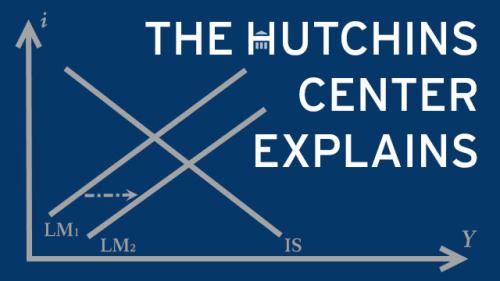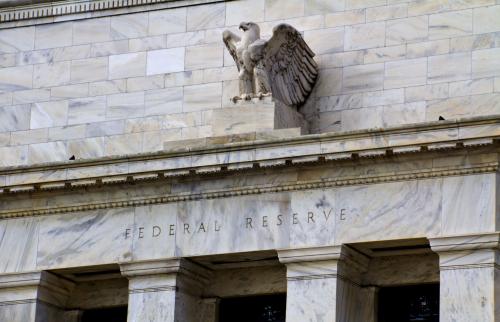This post was previously also updated by Kadija Yilla. It is based on a November 2017 blog by Michael Ng and David Wessel.
The leadership of the Federal Reserve has undergone substantial turnover in the past few years. President Biden has put four new governors on the seven-member Federal Reserve Board in Washington, and several of the 12 regional Fed banks have named new presidents.
By law, the president nominates a Fed chair and two vice chairs for four-year terms. They must be confirmed by the Senate for those positions in a vote distinct from their confirmation as members of the Fed Board of Governors. Jerome Powell was confirmed for a second four-year term as chair on May 12, 2022. Philip Jefferson was confirmed as vice chair on September 7, 2023. He succeeded Biden pick Lael Brainard, who left the Fed in early 2023 to head the White House Council of Economic Advisers. Michael Barr, another Biden nominee, was confirmed as vice chair for (bank) supervision on July 13, 2022, succeeding Trump pick Randal Quarles.
The other Biden choices for the Fed board were Lisa Cook, confirmed by the Senate in May 2022 and then confirmed a second time in September 2023 for a term that expires in 2038, and Adriana Kugler, confirmed in September 2023 for a term that expires in 2026.
The president and Senate have no say in picking presidents of the 12 regional Fed banks—they’re chosen by their private sector boards of directors, subject to the approval of the Fed Board of Governors in Washington.
Presidents of the regional Fed banks can serve until they’re 65—unless appointed after turning 55, in which case they can serve for a maximum of 10 years or until they’re 75, whichever comes first. For instance, Mary Daly, appointed on October 1, 2018, at the age of 55, falls into the second category, which means her term is up in October of 2028. Neel Kashkari, the youngest of the current regional presidents, can serve through 2038. Esther George of the Kansas City Fed retired in early 2023 after reaching the mandatory retirement age; Jeffrey Schmid was named her successor, effective August 21, 2023. James Bullard of the St. Louis Fed resigned before his mandatory retirement date to become dean of Purdue University’s business school; Alberto Musalem was named his successor, effective April 2, 2024. Loretta Mester of the Cleveland Fed reaches mandatory retirement age in June 2024; Beth Hammack has been named as her successor. (As Kaleb Nygaard has documented, this retirement rule dates to a 1936 decision by the Board of Governors.)
After press reports of their stock market trading raised eyebrows, Boston Fed President Eric Rosengren retired, citing health issues, on September 30, 2021, nine months earlier than his mandatory retirement, and Dallas Fed President Rob Kaplan retired on October 8, 2021, four years before his mandatory retirement date, because “recent focus on [his] financial disclosure risks becoming a distraction to the Federal Reserve.” The Boston Fed subsequently named Susan Collins as its new president, and the Dallas Fed named Lorie Logan.
Presidents of the 12 regional Fed banks are up for reappointment every five years. The Fed Board of Governors in Washington could replace any of them, though it hasn’t ever done so.
| Name | Must Leave By | Bank | Age Now | Age Appointed |
| Patrick Harker | June 2025 | Philadelphia | 65 | 56 |
| Thomas Barkin | January 2028 | Richmond | 62 | 56 |
| John Williams | June 2028 | New York | 62 | 56 |
| Mary Daly | October 2028 | San Francisco | 61 | 55 |
| Raphael Bostic | May 2031 | Atlanta | 58 | 51 |
| Susan Collins | July 2032 | Boston | 65 | 63 |
| Jeffrey Schmid | August 2033 | Kansas City | 66 | 65 |
| Alberto Musalem | April 2034 | St. Louis | 55 | 55 |
| Austan Goolsbee | August 2034 | Chicago | 54 | 53 |
| Beth Hammack* | January 2037 | Cleveland | 52 | 52 |
| Lorie Logan | February 2038 | Dallas | 51 | 49 |
| Neel Kashkari | July 2038 | Minneapolis | 50 | 42 |
* Loretta Mester reaches mandatory retirement age and will step down as of June 30, 2024. Hammack will take office August 21, 2024. Between the two, Cleveland Fed First Vice President Mark S. Meder will serve as interim president.
The Fed governors in Washington serve fixed 14-year terms that are staggered; one term expires every two years. If a governor leaves before his or her term is up, the successor completes their term. Governors filling unexpired terms can still be appointed to a new one, meaning that they can serve for more than 14 years. Only two Fed governors, however, have served for more than 14 years in the past half-century of Fed history. The median term length is a little over five years. By law, the president cannot remove a governor except “for cause,” a legal term that means he would have to show that the person had done something wrong.
| Fed Board Member | Term Expires |
| Adriana Kugler* | January 2026 |
| Jerome Powell | January 2028 |
| Christopher Waller* | January 2030 |
| Michael Barr* | January 2032 |
| Michelle Bowman | January 2034 |
| Philip Jefferson* | January 2036 |
| Lisa Cook | January 2038 |
*Filling an unexpired term, so could be reappointed.
Two of the current members of the Fed Board of Governors were initially appointed by Donald Trump (Bowman and Waller). Powell was originally appointed to the Board by Barack Obama in 2012 and was first named chair by Donald Trump. Powell’s term as chair expires in May 2026, and Michael Barr’s term as vice chair ends in July 2026. Philip Jefferson’s four-year term as vice chair expires in September 2027.
-
Acknowledgements and disclosures
The Brookings Institution is financed through the support of a diverse array of foundations, corporations, governments, individuals, as well as an endowment. A list of donors can be found in our annual reports published online here. The findings, interpretations, and conclusions in this report are solely those of its author(s) and are not influenced by any donation.




Commentary
Who has to leave the Federal Reserve next?
July 9, 2024